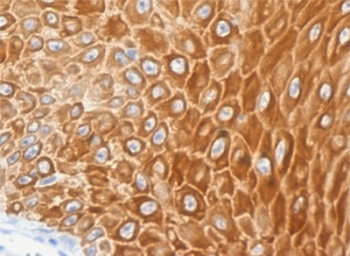- Tel: 858.663.9055
 Email: info@nsjbio.com
Email: info@nsjbio.com
- Tel: 858.663.9055
- Email: info@nsjbio.com
Cytokeratin 16 Antibody reagents target keratin 16 (KRT16), a type I intermediate filament protein expressed in keratinocytes of the nail bed, oral mucosa, tongue, and hair follicles. KRT16 is strongly induced during wound healing and in hyperproliferative skin disorders such as psoriasis. Partnering with keratin 6, KRT16 contributes to cytoskeletal stability and resilience under stress.
KRT16 mutations are linked to pachyonychia congenita, a rare genetic disorder characterized by thickened nails, oral leukokeratosis, and painful plantar keratoderma. Elevated KRT16 expression is also observed in squamous cell carcinomas and inflammatory skin conditions, making the Cytokeratin 16 Antibody a vital tool for dermatology, oncology, and regenerative medicine. The CK16 Antibody further supports applications across pathology, wound repair, and translational research.
NSJ Bioreagents provides Cytokeratin 16 Antibodies validated for immunohistochemistry, western blotting, immunofluorescence, and ELISA. Each Cytokeratin 16 Antibody undergoes rigorous testing to ensure specificity, reproducibility, and minimal background.
By selecting Cytokeratin 16 Antibodies from NSJ Bioreagents, researchers gain reagents optimized for clarity and consistency. Our antibodies provide reliable staining in skin and epithelial tissues, reproducible detection in lysates, and dependable performance across platforms. Detailed datasheets, suggested controls, and validated protocols further support reproducibility in both research and clinical applications.
The Cytokeratin 16 Antibody supports wide-ranging applications in skin biology, pathology, and oncology.
Cytokeratin 16 Antibodies detect KRT16 expression in nails, tongue, and hair follicles.
The Cytokeratin 16 Antibody highlights keratinocyte activation in psoriasis and other skin disorders.
CK16 Antibody reagents clarify keratin distribution in hyperproliferative tissues.
Cytokeratin 16 Antibodies detect mutations associated with pachyonychia congenita.
The Cytokeratin 16 Antibody supports research into keratinopathies affecting nails and mucosa.
CK16 Antibody reagents validate biomarkers for inherited epithelial disorders.
Cytokeratin 16 Antibodies monitor keratinocyte activation during wound closure.
The Cytokeratin 16 Antibody supports studies of stress-induced epithelial remodeling.
CK16 Antibody reagents provide translational tools for regenerative medicine.
Cytokeratin 16 Antibodies identify squamous cell carcinomas and other epithelial tumors.
The Cytokeratin 16 Antibody provides diagnostic support in pathology panels.
CK16 Antibody reagents support biomarker discovery in oncology research.
Cytokeratin 16 Antibodies confirm epithelial lineage in hyperproliferative lesions.
The Cytokeratin 16 Antibody supports dermatopathology in distinguishing skin disorders.
CK16 Antibody reagents contribute to diagnostic clarity in complex cases.
Cytokeratin 16 Antibodies are validated in biomarker-driven clinical studies.
The Cytokeratin 16 Antibody supports monitoring of therapeutic interventions in keratinopathies.
CK16 Antibody reagents provide reproducibility in precision medicine.
KRT16 is a key marker of hyperproliferative and stress-responsive epithelia. The Cytokeratin 16 Antibody enables precise detection of this protein, while the CK16 Antibody extends its applications across diagnostics, oncology, and regenerative research.
In dermatology, Cytokeratin 16 Antibodies highlight keratinocyte activation in psoriasis and inherited keratinopathies. In oncology, the Cytokeratin 16 Antibody supports tumor classification and prognosis. In wound healing research, CK16 Antibody reagents track epithelial repair and regeneration.
Clinically, KRT16 is an important biomarker for both inherited and acquired epithelial disorders. Cytokeratin 16 Antibodies provide reproducibility, reliability, and diagnostic confidence, bridging laboratory research with patient care.
Cytokeratin 16 is a hyperproliferation-associated keratin with roles in skin disease, wound repair, and cancer. The Cytokeratin 16 Antibody equips scientists and clinicians with validated reagents for detecting KRT16 in dermatology, oncology, and regenerative biology, while the CK16 Antibody provides complementary applications in diagnostics and translational medicine. By ensuring specificity and reproducibility, these antibodies remain indispensable for advancing keratin biology and improving patient outcomes.

IHC testing of FFPE human skin with recombinant Cytokeratin 16 antibody (clone CTKN16-1R, cat # V3737).